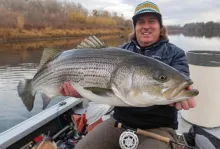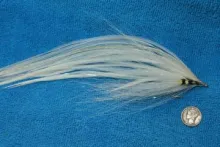This book is mainly on saltwater flies in spite of the title, and it doesn’t impress - or tell you how to design, develop or improve.
Updated or edited 10 months ago
When I started fly fishing in the salt, which was back in the dark ages of the eighties, one of the first names I bumped into was Lou Tabory. I read his book Inshore Fly Fishing in the early nineties and heard his name in many places – particularly when people were talking about fishing for striped bass.
On the back cover of this book, it's mentioned that he has been writing for fifty years. In other words: Tabory is no rookie.
This book isn't about fishing, but about fly tying, and the title implies that it's a book on general tying. That's not quite the case. It's a book that is mainly aimed at the saltwater fly angler, and the northern US coastal angler in particular. In spite of the subtitle mentioning freshwater, you won't find any nymphs, dries or even wet flies or streamers in the traditional sense in this book. The flies are for stripers, bluefish, bonefish and some can double for pike or large trout.
The title Making Better Flies made me think that this was a tying method book more than a pattern book, and that was my main motivation for buying it. But it is actually a pattern book.
And not even a good one, I'm sorry to say.
Now, don't get me wrong. I'm sure each of the patterns shown have been responsible for numerous catches and I don't doubt a minute that they are efficient flies. But man, they are boring!
OK... is a Deciever boring? Somewhat. Is a flatwing boring? Kinda. Is a Crazy Charlie boring? You could say that.
Are they killer flies? Sure they are! A good fly can easily be a boring fly, and as I said: Tabory's flies may be efficient... but material for a whole book called Making Better Flies...? Nope. That they aren't.
In spite of being fooled by the title and expecting some nifty tying tips, I gave the book a fair chance and of course read it.
Here's what I took away:
The introduction is so-so. A rundown of different saltwater prey species and their imitations is less than impressing. The flies and fish shown side-by-side aren't exactly convincing me that I'm going to find great tips on creating impressive imitations further along in the book.
Next comes a chapter on materials and tools. As always and again and again I have to stress that you need to set a level for your books and have a very well defined target group. A book on specialized flies (here saltwater, mainly northern American) and with a subtitle reading “How to Design, Develop and Improve Fly Patterns for Salt and Fresh Water” does NOT need a chapter on tying tools and vises unless these tools and vises are mentioned to help the reader “design, develop and improve fly patterns”. Tabory's tools are not. I'm pretty underwhelmed by his welding grip vise and the run-off-the-mill Regal. A picture of a couple of scissors, a bobbin holder and a bodkin isn't really a great help either, and the material and tool chapters are so bland and common that you might as well skip them and go on to the tying.
The tying then, that must be good, eh? Honestly? No...
The flies are, as already mentioned boring, very identical and even poorly tied. Bland, boring and poorly tied flies catch fish just as well as fancy, exiting and well tied flies, I know. But they don't belong in a book. A book like this should be a feast of varying and well tied patterns, contain great tips on improving your tying, and show you how to use methods, tools and materials to get the best possible flies. Even the boring and common flies should look great!
This is a list of about 30 patterns, most of them very identical, a large number basically just featuring bucktail, deer hair, a bit of chenille and some eyes. Even the colors are much the same, and in spite of Tabory touting the importance of the right color mix for a certain imitation, he essentially mixes the same few colors again and again to get a long row of cream/chartreuse/whitish flies. Same size, same basic shape, same materials and tying methods.
No, this book doesn't really deliver.
It's a book about a fairly identical series of flies for northern US saltwater species.
It's not a book about “How to Design, Develop and Improve Fly Patterns for Salt and Fresh Water”, I'm sorry to say.
- Log in to post comments







